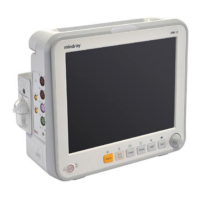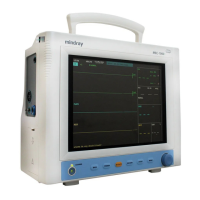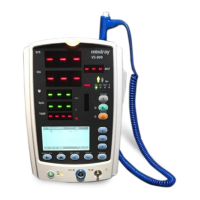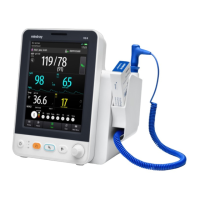7-2
7.2 Alarm Levels
By severity, the patient monitor’s alarms can be classified into three categories: high level,
medium level and low level.
Physiological alarms Technical alarms
High
level
Indicate that your patient is in a
life threatening situation, such
as Asystole, Vfib/Vtac and so
forth, and an emergency
treatment is demanded.
Indicate a severe device malfunction or an
improper operation, which could make it possible
that the monitor cannot detect critical patient status
and thus threaten the patient’s life, such as low
battery and so forth.
Medium
level
Indicate that your patient’s vital
signs appear abnormal and an
immediate treatment is
required.
Indicate a device malfunction or an improper
operation, such as ECG/SpO
2
lead off, which may
not threaten the patient’s life but may compromise
the monitoring of vital physiological parameters.
Low
level
Indicate that you patient’s vital
signs appear abnormal and an
immediate treatment may be
required.
Indicate a device malfunction or an improper
operation, which may compromise a certain
monitoring function but will not threaten the
patient’s life.
The level for some alarms, such as Asystole, Vfib/Vtac, etc., is predefined before the patient
monitor leaves the factory and cannot be changed. However, for most of the other
physiological alarms, alarm settings are user adjustable, e.g. alarm limits. For some
technical alarms, the alarm level is also user adjustable.
7.3 Alarm Indicators
When an alarm occurs, the patient monitor will indicate it to the user through visual or
audible alarm indications.
Alarm lamp
Alarm message
Flashing numeric
Audible alarm tones
Reminder tones

